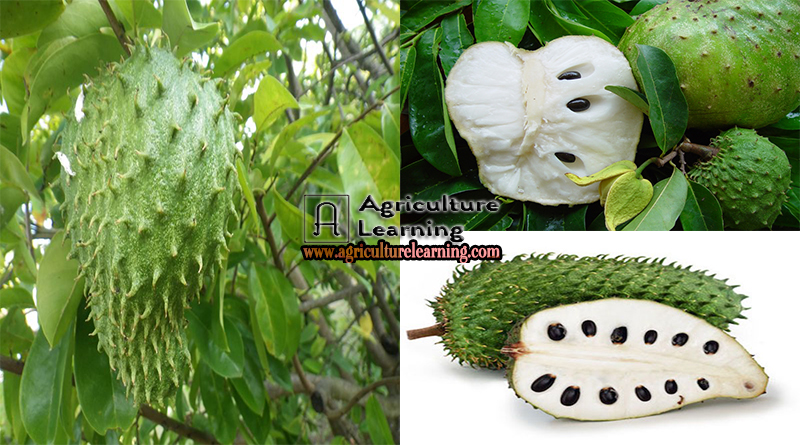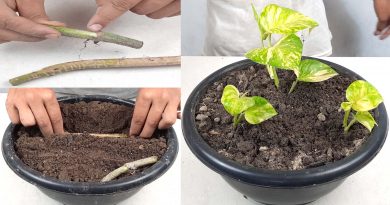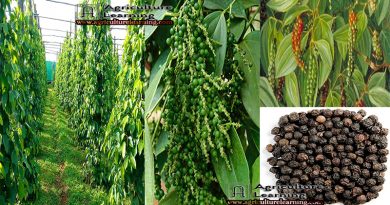Soursop Fruit Production Technology and it’s Health Benefits
Soursop fruit (Annona muricata), also called guanabana, Gaviola, or Brazilian pawpaw, tree of the custard apple family (Annonaceae), grown for its large edible fruits. Native to the American tropics, the tree has been widely introduced in the Old-World tropics. The fruit’s fibrous white flesh, which combines the flavors of mango and pineapple, can be eaten fresh and is strained to make custards, ice creams, and drinks. Soursop has been promoted as an alternative cancer treatment, but clinical studies in humans are lacking.
Reaching about 8 meters (26 feet), the soursop tree has broad-ended oval evergreen leaves about 12 cm (5 inches) long. The aromatic fruits are oval, spiny, and green-skinned; they grow about 20 cm (8 inches) long and weigh up to 4.5 kg (10 pounds). The plant is usually cultivated from seed and grows well in warm climates with high humidity.
Varieties of Soursop Fruit: There are mainly two types of Soursop fruits, sweet Soursop or sour Soursop. Generally, the sweet type is preferred for eating and the sour type is preferred for processing of juice.
Climate requirement: Soursop crop thrives well from sea level up to 300 to 400 meters. The Soursop trees are adapted to regions of high humidity and warm winters. The temperatures below 5 ᵒC may result in damage to tree leaves and small branches and the temperatures below 3 ᵒC can be more harmful. In these conditions, the Soursop fruits will become dry and not good for any concentrate.
Soil Requirement: The Soursop fruits can be grown in a wide range of soils. Moreover, it prefers loose, deep loamy, rice in organic matter and well-drained soils with ideal pH ranging from 6.0 to 6.5. Commercial growers of this fruit can go for the soil test to find out the suitability and soil fertility.
Propagation: The most common propagation method in Soursop fruit farming is done through seeds. Moreover, air layering, budding and grafting are also possible propagation methods.
Irrigation: Though these trees can tolerate drought conditions, it may require to keep the plant base moist for preventing from leaf shedding. There is no need for water in the rainy season. In case of flooding, make sure the plant basins are drained out quickly. Drip irrigation or flood irrigation can be carried out.
Fertilizers: The recommended fertilizer application is as follows; quarterly applications of 10-10-10 N:P:K- .225kg/tree the first years, .45 kg/tree the second year, 1.36kg/tree the third year and thereafter.
Pests and Diseases: The common insect pests found in Soursop fruit farming are; root grubs, fruit flies, mealy bugs, larva, scale insects. To prevent any damage from the fruit flies, the fruits on the tree can be bagged.
The common diseases found in Soursop fruit farming are; pink disease, root rot and anthracnose. To prevent those pests and disease, maintain clean conditions in the filed especially around the plant base. Destroy and diseased plants/branches.
Harvesting: The Soursop trees grow rapidly and begins to bear fruit in 3 to 5 years after planting in the field. Harvest the fruits when they are still green but fully developed. You must harvest these fruits while they still firm and yellow-green in color. Usually, at the time of maturity, the shiny green color of fruits turns into a dull green color. Fruits may ripen throughout the year. However, there are 1 to 3 harvest periods/year.
Yield: Yields are generally low and can expect 20 to 24 fruit per/tree/year. On average, these fruits weigh about 1 to 1.5 kg.
Health Benefits of Soursop Fruit:
- Soursop leaves can treat back pain.
- Soursop leaves can greatly help in treating gout.
- Soursop leaves can prevent cancer cells growth.
- Soursop leaves can help in treating diabetes.
- Soursop leaves help in fighting with infections.
- Soursop leaves may boost immune system.
- Eczema can be treated by Soursop leaves due to its anti-inflammatory properties.




